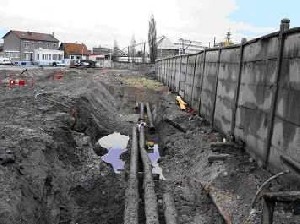As part of the ongoing dismantling taking place in a lubricant depot, a subcontractor disassembled aerial pipes connected to the depot network as well as their concrete foundations. During these operations, the removal of one of the blocks led to extracting a segment of underground pipe that neither the depot nor the subcontractor knew about and whose purpose was unclear. In reality, this pipe was one of the three supplying oil products to a neighbouring depot directly from the fuel transit terminal. On the morning of December 15, a fuel oil delivery intended for this depot was ordered. The delivery conveyed through the pipe that had been partially extracted 2 days earlier caused an oil spill. The depot operator, warned by the lubricant depot subcontractor, activated the emergency shutdown of the fuel transfer process in order to stop the leak, yet could not avoid the spillage of 370 m³ contained in the abandoned site. A shutdown order was served to the site operator on December 21 imposing remedial measures to be taken (site monitoring conditions, pollution assessment, pollution cleanup of the soil and subsoil, treatment of polluted ground, etc.). The oil reached the underground water at 4 m deep but no immediate and mid-term contamination of neighbouring basin and of the SEINE was detected. Pumping capacities were settled on the site and on the neighbouring drainage system on December 16th : 3 months later, approximately 70% of the hydrocarbons were recovered. 2500 m² of soil needed decontamination : 1800 t of soil were excavated. The supplying of hydrocarbons by pipeline was suspended during 1 month, till the rehabilitation of the 3 pipelines. Total costs involved by this incidents, including decontamination, loss of production and material damages were assessed at 1,5 M including 550 000 .for the rehabilitation of the 3 pipelines.Measures shall be taken on both technical (hydrocarbon detectors at the carrier terminal manifold, tightness of bunds at the transfer and reception zones, installation of sound and/or visual alarm systems in the operational area of the oil terminal that indicates the start of tank filling) and organisational levels (revision of procedures on monitoring of reception by the pipeline during and outside working hours, drawing-up of a formal protocol stating the responsibility of pipeline and oil terminal operators). The document resources must be properly managed (plans of facilities at risk) and the site-related information and its background must be communicated to the sub-contractors for the successful completion of such types of projects.
Download the detailed report in .pdf format (67 Kb)





